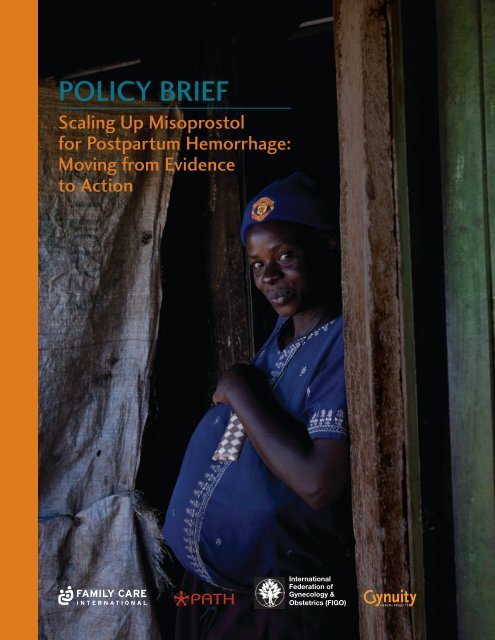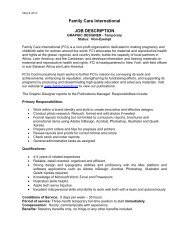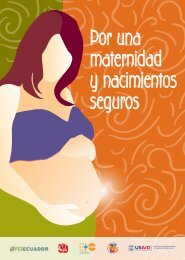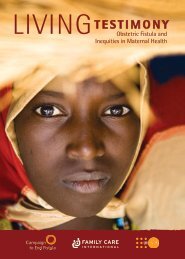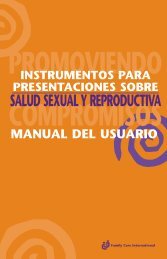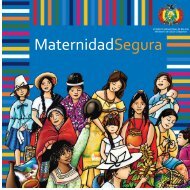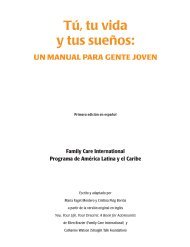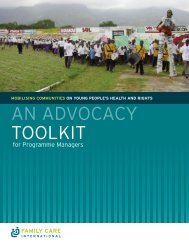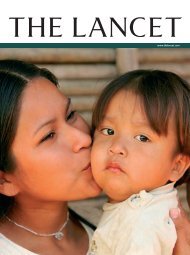Scaling Up Misoprostol for Postpartum Hemorrhage - Family Care ...
Scaling Up Misoprostol for Postpartum Hemorrhage - Family Care ...
Scaling Up Misoprostol for Postpartum Hemorrhage - Family Care ...
- No tags were found...
You also want an ePaper? Increase the reach of your titles
YUMPU automatically turns print PDFs into web optimized ePapers that Google loves.
POLICY BRIEF<strong>Scaling</strong> <strong>Up</strong> <strong>Misoprostol</strong><strong>for</strong> <strong>Postpartum</strong> <strong>Hemorrhage</strong>:Moving from Evidenceto ActionFAMILY CAREI N T E R N AT I O N A LInternationalFederation ofGynecology &Obstetrics (FIGO)
IntroductionGlobally, postpartum hemorrhage (PPH)—excessive bleeding after childbirth—is the leading cause ofmaternal death and injury. Yet, most cases of PPH can be safely and effectively prevented and/or treatedin virtually all settings. Lifesaving uterotonic medicines, including oxytocin and misoprostol, can preventexcessive bleeding and reduce bleeding after it has started. Use of misoprostol—particularly <strong>for</strong> womenwho give birth at home or in facilities that lack basic supplies, medicines, and infrastructure—offers anunprecedented opportunity <strong>for</strong> countries to improve maternal health and achieve Millennium DevelopmentGoal (MDG) 5. This brief explores strategies to help governments and their partners reduce maternalmortality by expanding access to misoprostol <strong>for</strong> PPH.PPH accounts <strong>for</strong> an estimated 25% of maternal deaths worldwide, with regional estimates<strong>for</strong> Africa and Asia considerably higher at 33.9% and 30.8%, respectively. 1,2If uterotonics—including misoprostol—were made available at every birth over a ten-yearperiod, 41 million cases of PPH would be prevented and 1.4 million lives could be saved. 3Uterotonic medicines (including oxytocin and misoprostol) increase the frequency andstrength of uterine muscle contractions, causing the blood vessels to compress to reducethe incidence and severity of PPH. 4,5Benefits of misoprostol: safe and effective, easy to administer, cost-effective, widelyavailable, stable at room temperature, practical <strong>for</strong> use in home births and health facilities.<strong>Misoprostol</strong> can be administered orally (600mcg) to prevent PPH or sublingually (800mcg)to treat PPH once it has begun.Expanding access to misoprostol <strong>for</strong> PPHOver the last decade, significant progress has been made in improving maternal health. Ongoing ef<strong>for</strong>tsto increase access to skilled care, to promote facility-based births, and to strengthen health systems arecritically important and should be expanded vigorously wherever possible. In the short term, however,not all women are able to give birth in health facilities. It must be an urgent priority, there<strong>for</strong>e, to pursuestrategies to safeguard the lives of women who deliver at home. All women, wherever they give birth, needaccess to a uterotonic <strong>for</strong> the prevention and treatment of PPH.Oxytocin is the first-line choice <strong>for</strong> prevention and treatment of PPH;however it requires cold storage and health providers with the skillsand equipment to provide intravenous therapy.Backed by multi-country research, national-level experience, andinnovative programming, a new global consensus is emergingthat expands the options <strong>for</strong> prevention and treatment <strong>for</strong> PPH.<strong>Misoprostol</strong> is the best available option <strong>for</strong> preventing and treatingPPH in settings where conditions <strong>for</strong> use of oxytocin do not exist, andis a safe, effective, and af<strong>for</strong>dable medicine <strong>for</strong> use in low-resourcesettings. Community-level access to misoprostol can be an especiallycritical strategy <strong>for</strong> countries with low levels of facility-based deliveriesand acute shortages of trained health care personnel. 62 <strong>Scaling</strong> <strong>Up</strong> <strong>Misoprostol</strong> <strong>for</strong> <strong>Postpartum</strong> <strong>Hemorrhage</strong>: Moving from Evidence to Action
Key elements <strong>for</strong> introducing misoprostol <strong>for</strong> PPH:• Creating a supportive national policy• Including misoprostol in nationalhealth budgets• Preparing and disseminating nationalclinical guidelines• Training health workers• Ensuring consistent supply and distribution• Building community awareness and demandSkilled birth attendance is still not accessible <strong>for</strong> millions of women in developingcountries. Today, 35% of all deliveries in developing countries are not attended by skilledhealth personnel. 7The International Federation of Gynecology and Obstetrics (FIGO) and the InternationalConfederation of Midwives (ICM) support misoprostol as a safe and effective strategyto prevent and treat PPH in low-resource settings. New global guidance on communitybaseddistribution of misoprostol <strong>for</strong> PPH prevention—when oxytocin is unavailable or notfeasible—is available from FIGO 8,9 and the World Health Organization (WHO) in 2012. 10Creating a supportive national policyA number of countries in Africa and Asia havelaunched national programs that includemisoprostol <strong>for</strong> PPH. In countries newlycommitted to scaling up misoprostol <strong>for</strong> PPH,establishing supportive national policies can bean important—but not sufficient—first step. Theadoption of national guidelines, the registration ofmisoprostol <strong>for</strong> PPH, and its inclusion on nationalEssential Medicines Lists (EMLs) are amongsupportive policies <strong>for</strong> advancing the availabilityand uptake of misoprostol <strong>for</strong> PPH.In some countries it has been a considerablechallenge to move beyond the initial steps, i.e.,from registering misoprostol and developingsupportive national policies to increasingavailability and distribution. As countries beginplanning implementation at scale, it will beimportant to consider what tools and mechanismsare available to move policies into practice and toaddress barriers that might emerge. Further, oncemisoprostol has been approved on national EMLs,it will be essential <strong>for</strong> governments to include thepurchase of this medicine in national budgets.<strong>Scaling</strong> <strong>Up</strong> <strong>Misoprostol</strong> <strong>for</strong> <strong>Postpartum</strong> <strong>Hemorrhage</strong>: Moving from Evidence to Action3
Providing national guidance and trainingNational guidance on administration of misoprostol <strong>for</strong> PPH can support safe and effective use; trainingcurricula <strong>for</strong> health workers, standard treatment guidelines, and reference materials should be updatedas new evidence and guidelines become available. Further, national clinical guidelines often indicate whichcadre of health provider is authorized to administer specific medications. In many countries low andmid-level health workers are already administering misoprostol; governments should consider authorizing,properly training, and providing clear guidelines <strong>for</strong> these workers.In 2009, Ghana approved National Safe Motherhood Protocols authorizing community-levelproviders to administer misoprostol to prevent PPH. These protocols have become the cornerstoneof Ghana’s ef<strong>for</strong>ts to scale up misoprostol <strong>for</strong> prevention of PPH. 11Training health providersSupporting the rollout and distribution of misoprostol <strong>for</strong> PPH prevention and treatment, either at thecommunity or health facility level, requires identification, training, and mobilization of a sufficient androbust work<strong>for</strong>ce. For many countries confronting acute shortages in health personnel, this will present aconsiderable challenge.In recent years, Ethiopia has demonstrated the potential <strong>for</strong> countries to rapidly train and expandtheir health work<strong>for</strong>ce. Between 2003 and 2010, Ethiopia trained 30,000 health extension workersand deployed them to health posts throughout the country, expanding coverage of key health servicesto even the most remote settings. Ef<strong>for</strong>ts to train health extension workers across the countryin use of misoprostol <strong>for</strong> prevention of PPH at community-level births are underway. 12,13Ensuring consistent supplyand distributionIn addition to developing a nationalstrategy to scale up misoprostol,countries will need to purchase anddistribute this medicine at scale.New national-level policies andguidance must be backed by anadequate, safe, and af<strong>for</strong>dable supplyof good quality misoprostol and themechanisms to deliver it effectivelyand reliably to women. Despitethe fact that misoprostol is widelyproduced and relatively inexpensive,some countries have experiencedchallenges ensuring adequate andconsistent national supplies. Itwill be important <strong>for</strong> countries toidentify local or global manufacturerswilling and able to bring a qualitymisoprostol product to market atsufficient quantities.4 <strong>Scaling</strong> <strong>Up</strong> <strong>Misoprostol</strong> <strong>for</strong> <strong>Postpartum</strong> <strong>Hemorrhage</strong>: Moving from Evidence to Action
Recent innovations in mobile health (mHealth) to support supply chain management can improveefficiencies and address challenges in <strong>for</strong>ecasting and ensuring a reliable supply of misoprostol.Programs using text messaging (SMS) to collect and monitor stock-level data <strong>for</strong> essential medicineshave been highly effective in increasing access to and reducing stock-outs of these medicines. 14Global mechanisms and international supportFor many countries, complex national registration processes and challenges with <strong>for</strong>ecasting andprocurement mechanisms have made the purchase of misoprostol expensive and burdensome. Leadershipby international agencies in creating efficiencies in supply and distribution will be crucial <strong>for</strong> countriescommitted to rolling out this approach.The WHO Prequalification of Medicines Program evaluates the safety, quality, and efficacy of medicines,and facilitates global and national procurement by ensuring international standards are metand maintained. 15 Prequalification of a misoprostol product could expand access and availability ofmisoprostol and enable agencies like the United Nations Population Fund (UNFPA) to use their vastnetwork to support the planning, pooled procurement, and efficient delivery of misoprostol.In 2011, misoprostol <strong>for</strong> prevention of PPH was added to WHO’s Essential Medicines List, guidingcountries to include misoprostol in national EMLs and to prioritize a safe and consistent supply.Evidence has shown that pooled procurement and bulk purchasing strategies can be highly effectivemechanisms <strong>for</strong> countries challenged by the cost of commodities or the complexity of sourcing newcommodities from manufacturers. A number of regional and global pooled procurement mechanisms,such as the Pan American Health Organization (PAHO) Revolving Fund and UNFPA Global Programme<strong>Scaling</strong> <strong>Up</strong> <strong>Misoprostol</strong> <strong>for</strong> <strong>Postpartum</strong> <strong>Hemorrhage</strong>: Moving from Evidence to Action5
to Enhance Reproductive Health Commodity Security (GPRHCS), have enabled countries to obtaincommodities at a reduced cost, facilitated rigorous quality assurance beyond the capacity of any onecountry, and increased the consistency of supply by demonstrating reliable and sizable demand tomanufacturers.Global ef<strong>for</strong>ts to increase access to maternal health commodities provide important opportunitiesto expand use of misoprostol <strong>for</strong> PPH:• The UN Commission on Life-Saving Commodities <strong>for</strong> Women and Children seeks to increase accessto life-saving commodities <strong>for</strong> women and children by improving production, distribution, and use. 16• The Maternal Health Supplies Working Group—chaired by PATH and Population ActionInternational—was launched in 2010 to increase resources, improve policies, and foster politicalwill to expand access to maternal health supplies.• UNFPA’s Global Programme to Enhance Reproductive Health Commodity Security (GPRHCS)provides technical and financial support to enable governments to effectively access and distributereproductive and maternal health medicines and supplies. 17,18PackagingSeveral studies have found that misoprostol can becorrectly used by community health workers <strong>for</strong> PPHprevention when packaged specifically <strong>for</strong> this use.Currently, only a few of the global manufacturersof misoprostol produce the three-pill blister packto support correct dosing <strong>for</strong> PPH prevention andprevent degradation during storage. The developmentof appropriate packaging by international andnational manufacturers, <strong>for</strong> both prevention (600mcgadministered orally) and treatment (800mcgadministered sublingually) of PPH, should beprioritized as procurement mechanisms are developedand countries scale up distribution. Pilot experiencehas shown specific packaging <strong>for</strong> PPH facilitates easeof use and acceptability among end-users.In Afghanistan, misoprostol was packaged <strong>for</strong> PPH prevention in sealed paper packets withthree 200mcg tablets and labeled with pictures and written instructions specifically to facilitatedistribution by community health workers. In this pilot program, the packaging, supported byeducation and training, led to high levels of correct use by community health workers andby women. 19Building community awareness and demandCommunity-based distribution of misoprostol can be an essential element in a country’s strategy<strong>for</strong> addressing PPH. Such ef<strong>for</strong>ts can and should be embraced by health providers, women, andtheir communities, and strategically integrated into existing health systems as part of a continuumof care <strong>for</strong> PPH.6 <strong>Scaling</strong> <strong>Up</strong> <strong>Misoprostol</strong> <strong>for</strong> <strong>Postpartum</strong> <strong>Hemorrhage</strong>: Moving from Evidence to Action
Increasing acceptability, demand, and use of misoprostol <strong>for</strong> PPH among women and their communitiesis as essential as building the systems <strong>for</strong> supply and distribution. Community awareness and educationcampaigns on the use of misoprostol <strong>for</strong> prevention of PPH have been successful in many countries. Manyof these programs combined demand-creation and awareness-raising activities with ef<strong>for</strong>ts to distributemisoprostol <strong>for</strong> use at home births.In Tangail District in Bangladesh, the Mayer Hashi pilot project demonstrated high acceptability anddemand among both health workers and women themselves; 92% of the women who had receivedthe medicine in advance were successfully able to self-administer it. 20Conclusion: Moving from evidence to actionFor the first time, a convergence of global leadership, national commitment, and solid experience canmake the rapid introduction and scale-up of misoprostol <strong>for</strong> PPH a reality in countries where postpartumhemorrhage remains a major cause of suffering and death. National governments and partners need towork together to ensure that every community and every woman has access to a uterotonic <strong>for</strong> preventingand treating postpartum hemorrhage.<strong>Scaling</strong> <strong>Up</strong> <strong>Misoprostol</strong> <strong>for</strong> <strong>Postpartum</strong> <strong>Hemorrhage</strong>: Moving from Evidence to Action7
Endnotes1World Health Organization, Systematic Review of Causes of Maternal Death, 2010.2Khan, Khalid et al., WHO analysis of causes of maternal death: a systematic review. The Lancet, Vol 367, Issue 9516.Pages 1066-1074, 1 April 2006, doi 10.1016/S0140-6736(06)68397-9.3Seligman, Barbara and Xingzhu Liu, Economic Assessment of Interventions <strong>for</strong> Reducing <strong>Postpartum</strong> Hemorhage inDeveloping Countries, Abt Associates Inc., 2006.4Wilson, R. et al. Medicines <strong>for</strong> Maternal Health Working Paper. Prepared <strong>for</strong> the United Nations Commission onLife-Saving Commodities <strong>for</strong> Women and Children, 2012.5POPPHI. Prevention of <strong>Postpartum</strong> <strong>Hemorrhage</strong>: Implementing Active Management of the Third Stage of Labor (AMTSL):A Reference Manual <strong>for</strong> Health <strong>Care</strong> Providers. Seattle: PATH; 2007.6Starrs, Ann and Winikoff, Beverly, <strong>Misoprostol</strong> <strong>for</strong> postpartum hemorrhage: Moving from evidence to practice. Int JGynecol Obstet 116 (2012) 1–3.7WHO, UNICEF, UNFPA and The World Bank. Trends in Maternal Mortality: 1990-2010. Geneva: World HealthOrganization, 2012. Available at: http://www.unfpa.org/webdav/site/global/shared/documents/publications/2012/Trends_in_maternal_mortality_A4-1.pdf8International Federation of Gynecology and Obstetrics. FIGO Guideline. Prevention of postpartum hemorrhagewith misoprostol. Int J Gynecol Obstet 2012: 119(3).9International Federation of Gynecology and Obstetrics. FIGO Guideline. Treatment of postpartum hemorrhage withmisoprostol. Int J Gynecol Obstet 2012: 119(3).10World Health Organization Recommendations <strong>for</strong> the Prevention and Treatment of <strong>Postpartum</strong> Haemorrhage. Geneva,World Health Organization, 2012.11National Safe Motherhood Protocols, Ministry of Health, Ghana, 2009.12Blake, Sarah, et al. UN Commission on Life Saving Commodities <strong>for</strong> Women and Children: Country Case Studies.Maternal Health Task Force and Global Health Visions, 2012. Available at: http://maternalhealthtask<strong>for</strong>ce.org/components/com_wpmu/wp-content/uploads/blogs.dir/1/files/2012/06/UN-Commission-<strong>for</strong>-Lifesaving-Commodities_Country-Case-Studies_June-2012-clean.pdf13Prata, N., A. Gessessew, A.K Abraha, M. Holston, and M. Potts. Prevention of <strong>Postpartum</strong> <strong>Hemorrhage</strong>: Options <strong>for</strong>Home Births in Rural Ethiopia. African Journal of Reproductive Health, 2009: 87-95.14Blake, Sarah, et al. UN Commission on Life Saving Commodities <strong>for</strong> Women and Children: Country Case Studies. MaternalHealth Task Force and Global Health Visions, 2012. Available at: http://maternalhealthtask<strong>for</strong>ce.org/components/com_wpmu/wp-content/uploads/blogs.dir/1/files/2012/06/UN-Commission-<strong>for</strong>-Lifesaving-Commodities_Country-Case-Studies_June-2012-clean.pdf15Prequalification of Medicines by WHO. Available at: http://www.who.int/mediacentre/factsheets/fs278/en/index.html16UN Commission on Life-Saving Commodities <strong>for</strong> Women and Children Available at: http://www.everywomaneverychild.org/resources/un-commission-on-life-saving-commodities17UNFPA. The Global Programme to Enhance Reproductive Health Commodity Security: Annual Report. New York: UNFPA, 2011.Available at: http://www.unfpa.org/webdav/site/global/shared/documents/publications/2012/GPRHCS_AR_7_6_12-1.pdf18UNFPA Global Programme to Enhance Reproductive Health Commodity Security (GPRHCS). Available at: http://www.unfpa.org/public/supplies/pid/359119Sanghvi, Harshadkumar et al., Prevention of postpartum hemorrhage at home birth in Afghanistan. Int J Gynecol Obstet 108(2010) 276-281.20Mayer Hashi Project. Community-based distribution of misoprostol <strong>for</strong> the prevention of postpartum hemorrhage: Evaluationof a pilot intervention in Tangail District, Bangladesh. Dhaka: EngenderHealth/Mayer Hashi Project, 2012.This brief was written by Aubrey Cody, MPH, and Sarah Goltz, MPH, MIA of Sage Innovation.Copyright © 2012 by <strong>Family</strong> <strong>Care</strong> International. Photo Credits: Richard Lord, Joey O’Loughlin.588 Broadway, Suite 503New York, NY 10012 USApphproject@familycareintl.orgwww.familycareintl.org


